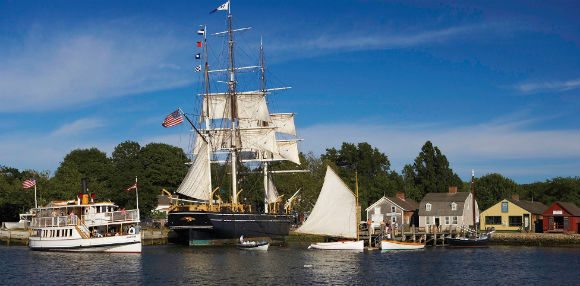 Sadly, this is not an April Fools joke. The Mystic Seaport Museum is another casualty of Covid-19, at least for the duration of the pandemic. The Hartford Courant reports that as of today the museum is closing indefinitely and laying off 199 employees, 68 of which are full-time, according to a letter filed by the organization with the Connecticut Department of Labor.
Sadly, this is not an April Fools joke. The Mystic Seaport Museum is another casualty of Covid-19, at least for the duration of the pandemic. The Hartford Courant reports that as of today the museum is closing indefinitely and laying off 199 employees, 68 of which are full-time, according to a letter filed by the organization with the Connecticut Department of Labor.
While the period of time that the museum is closed is indefinite, the Seaport is not shutting down. From a statement titled “Our Business Goes On” on the Seaport website:
We recently had to make the difficult and upsetting decision to reduce our workforce. This move was taken only as a last resort to preserve our ability to reopen to the public when this crisis has passed.
Some have understood the move to mean that the Museum is permanently closing. Contrary to a media report, that conclusion is absolutely not the case. Be assured the business of the Museum continues. There is a corps of dedicated staff members who are making sure the institution’s collections – ashore and afloat – the campus, and its intellectual assets are preserved and maintained. They will ensure we will be in a position to reopen to the public as soon as the State of Connecticut issues us permission to do so and we are certain we can do so safely.
The museum had shut its doors on March 13th with the intention of reopening on March 30th. The recent filings are required by the Federal WARN Act, which mandates that employers with more than 100 workers provide advance notice of layoffs affecting 50 or more of their employees at a single site.
The museum was founded in 1929 and is home to more than 500 historic watercraft including the last surviving wooden whaling ship, the Charles W. Morgan, built in 1841. The staff included scholars, librarians, historic interpreters, educators, scientists, musicians, and skilled shipwrights and artisans.
Mystic Seaport Museum is the largest maritime museum in the United States. Located in Mystic, CT, it features a restored 19th-century seafaring village of more than 60 original historic buildings on the 37-acre site. Four of the museum’s vessels have been recognized by the United States Government as National Historic Landmarks — the whaleship Charles W. Morgan; the 1921 built fishing schooner L. A. Dunton; the Emma C. Berry, the last surviving American well smack built in 1866; and the wooden, coal-fired steamboat Sabino, built in 1908.
The museum is also home to the Henry B. duPont Preservation Shipyard, where the replica Mayflower II is currently undergoing restoration. The Seaport also supports research via an extensive library and has run the Frank C. Munson Institute of American Maritime Studies, a summer graduate-level academic program established in 1955 by maritime historian Professor Robert G. Albion of Harvard University. The museum also hosts Williams–Mystic in conjunction with Williams College, an undergraduate program in maritime studies.
While the Seaport may be physically closed, it can be visited virtually here.
